Activated Sludge Process:-
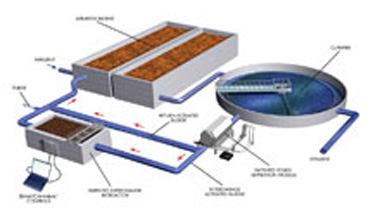
Introduction:-
In general, the activated sludge process is a continuous or semi continuous (fill
and draw) aerobic method for biological wastewater treatment, including carbonaceous
oxidation and nitrification. This process is based on the aeration of wastewater
with flocculating biological growth, followed by separation of treated wastewater
from this growth. Part of this growth is then wasted, and the remainder is returned
to the system. Usually, the separation of the growth from the treated wastewater
is performed by settling (gravity separation) but it may also be done by flotation
and other methods. Lichens also deals with modification of Activated sludge like
extended aeration etc.
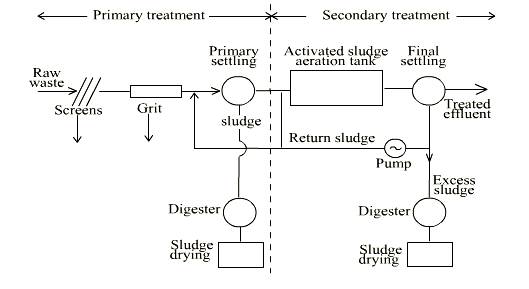
Typical ASP (Activated Sludge Process) Process Flow diagram
Purpose:-
- oxidizing carbonaceous matter: biological matter.
- oxidizing nitrogeneous matter: mainly ammonium
and nitrogen in biological materials.
- removing phosphate.
- driving off entrained gases carbon dioxide, ammonia,
nitrogen, etc.
- generating a biological floc that is easy to settle.
- generating a liquor low in dissolved or suspended
material.
Rotating Biological Contactor(RBC):-
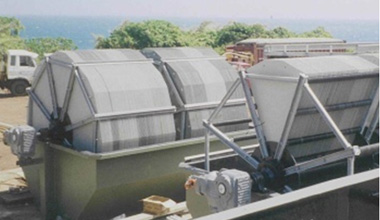
Introduction:-
Rotating biological contactors (RBCs) is a remediation technology used in the secondary
treatment of wastewater.
This technology involves allowing wastewater to come in contact with a biological
medium in order to facilitate the removal of contaminants. There are several different
designs now available, but in its simplest form a rotary biological contactor (RBCs)
consists of a series of discs mounted on a shaft, which is driven so that the discs
rotate at right angles to the flow of settled sewage.
Working Principle:-
The RBC process consists of a large disc with radial and concentric passages slowly
rotating in a concrete tank. The rotation and subsequent exposure to oxygen allows
organisms to multiply and form a thin layer of biomass. This large, active population
causes the biological degradation of organic pollutants. Excess biomass shears off
at a steady rate and is then carried through the RBC system for removal in a clarifier.
Applications:-
Residential/Commercial Complexes, Hotels, Restaurants, I.T. Parks, Theme Parks,
Amusement Parks, Golf Courses, Hospitals, Resorts, Camps, industrial Townships,
Educational Institutions, Isolated Clusters, Small & Medium Industries, Bus/Air/Rail
Terminals/Depots, etc. Besides this, Municipalities can adopt this technology for
conversion of sewage in to secondary grade reuse/recycle water and for aquifer recharge
programme.
Advantages:-
These rotating biological contactors offer many advantages like:
- The capability of handling a wide range of flows.
- Low power requirements
- Low sludge requirements
- Excellent process control.
- Maintenance and housekeeping requirements are
minimal.
- Only basic operator skills required.
Submerged Aeration Filter(SAF):-
Introduction:-
Submerged Aerobic Filter (SAF) incorporates the advantages of Fixed
Film Technology combined with Fine bubble Diffused Aeration. SAF is highly suitable
for medium and low strength wastewater. Lichens design good quality
submerged aerated filter to reduce the amount of BOD and ammoniacal nitrogen in
settled sewage and industrial effluents. BOD removal efficiency possible of SAF
reactor is 95 - 97%.
Basic Structure :-
The Lichens SAF is a fabricated steel tank split into treatment cells, arranged
in series. Each cell houses a number of fine bubble membrane diffusers, which are
mounted below a packed rigid corrugated PVC media.
Working Principle:-
The Aerated effluent is passed via submerged media which acts as a physical support
for the growth of micro organisms. The Submerged aerated filters are seeded with
bacterial cultures to accelerate start-up. Air is introduced in the filter from
perforated pipes, from nozzles or from fine bubble diffusers located below the media
support structure.
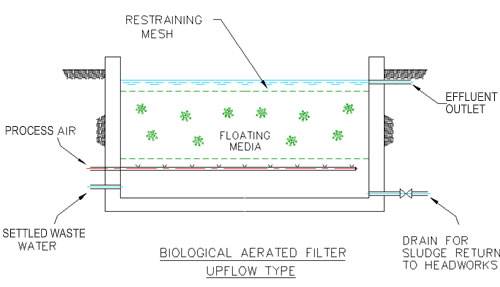
Applications:-
- Municipal & Domestic Sewage Treatment
- Industrial Wastewater Effluents including
- Abattoirs
- Breweries
- Chemical Processing
- Dairies
- Distilleries
- Food Processing
- Pharmaceuticals
- Textiles
- Landfill and Bioremediation
- Permanent wastewater treatment plants
- Mobile emergency response treatment units
- Temporary treatment during planned maintenance
- Propping up biologically overloaded works
- Leachate treatment
- Industrial waste treatment
- Pilot studies
Advantages:-
- Lower Capital Cost.
- Higher BOD/ COD removal efficiency.
- Higher resistance to shock loading.
- Consistent performance.
- Lower Space/ Power Requirement.
- Quick & easy installation.
- Completely mixed and highly oxygenated discharge.
- Degradation of fats, oils and grease (FOG) .
- Non-chemical pH control.
- Protects biological secondary treatment from harmful
VOCs .
- Minimal O&M requirements.
- Guaranteed system performance
- Produces high effluent qualities; tolerates variations
in biological and solids loadings
- Eliminates the high headloss conditions allowing
the use of deeper media beds
- Eliminates the plugging potential typically associated
with BAF
- Eliminates air and water distribution problems
- No backwashes are required
- Process air blowers and low head feed pumps constitute
the only major power requirement
- Minimal process monitoring is required releasing
valuable operator time
- Utilizes a durable media with a long proven performance
life in excess of 20 years
- No moving or serviceable parts
- Small footprint
Moving Bed Bio Reactor (MBBR):-
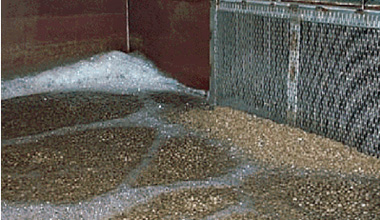
Introduction:-
Wastewater treatment plants of a medium or small scale require a simple equipment
composition and easy maintenance. The Moving-Bed type bioreactor has largely simplified
the washing mechanism by washing filtering media parallel to the reactor processing.
Basic Structure:-
The Lichens MBBR is a variant of submerged aerated filter technology. It provides
a small footprint solution for carbonaceous, nitrification, C+N or in anoxic mode
for de-nitrification treatment with very low capital and operating costs together
with a low head loss.
The MBBR can be designed as a small footprint process solution for a new works,
or as a retro-fit to an existing activated sludge plant to increase capacity and
improve effluent quality. It can also be operated in applications of high ammonia
concentration – such as sludge liquor treatment or leachate treatment - with
the continuously moving bed format in order to provide the oxygenation required
for the higher load.
Working Principle:-
MBBR is a combination of attached growth as well as suspended growth which easily
degrade the organic matter present in waste water.
Applications:-
- Municipal & Domestic Sewage Treatment
- Industrial Wastewater Effluents including
- Abattoirs
- Breweries
- Chemical Processing
- Dairies
- Distilleries
- Food Processing
- Pharmaceuticals
- Textiles
- Landfill and Bioremediation
- Permanent wastewater treatment plants
- Mobile emergency response treatment units
- Temporary treatment during planned maintenance
- Propping up biologically overloaded works
- Leachate treatment
- Industrial waste treatment
- Pilot studies
Advantages:-
- Simplified facilities
The back washing device requires only the air-compressor for the air-lift,
and not the back-washing pump, blower, or tank that was needed for the fixed bed
type reactor.
- Simplified construction work
A steel reactor is manufactured at the factory to facilitate the field work, so
that the construction term can be shortened.
- Flexible response to the wastewater treatment projects
- Lower Capital Cost.
- Higher BOD/ COD removal efficiency.
- Higher resistance to shock loading.
- Consistent performance.
- Lower Space/ Power Requirement.
- Quick & easy installation.
- Completely mixed and highly oxygenated discharge.
- Degradation of fats, oils and grease (FOG) .
- Non-chemical pH control.
- Protects biological secondary treatment from harmful VOCs .
- Minimal O&M requirements.
- Guaranteed system performance
- Produces high effluent qualities; tolerates variations in biological
and solids loadings
- Eliminates the high headloss conditions allowing the use of deeper
media beds
- Eliminates the plugging potential typically associated with BAF
- Eliminates air and water distribution problems
- No backwashes are required
- Process air blowers and low head feed pumps constitute the only major
power requirement
- Minimal process monitoring is required releasing valuable operator
time
- Utilizes a durable media with a long proven performance life in excess
of 20 years
- No moving or serviceable parts
- Small footprint